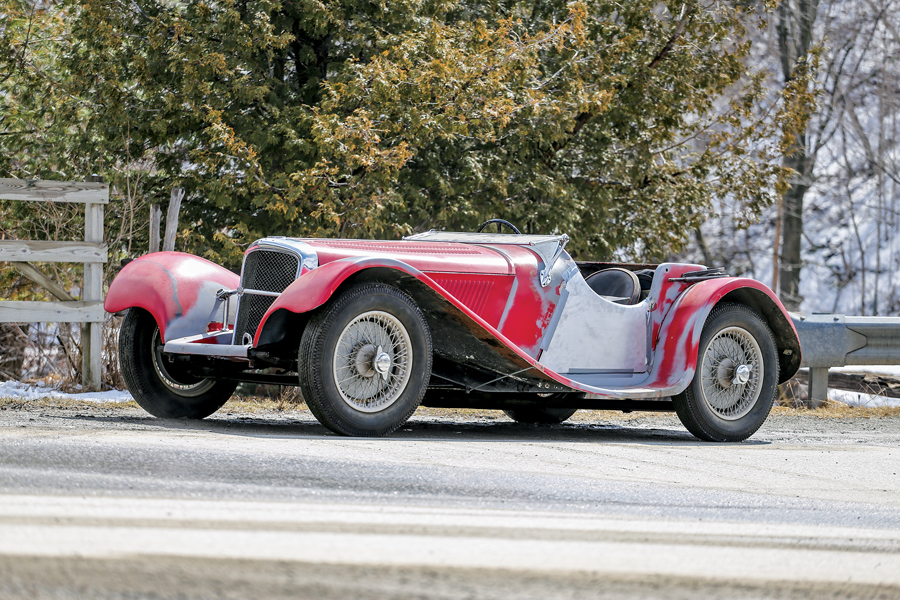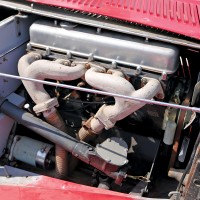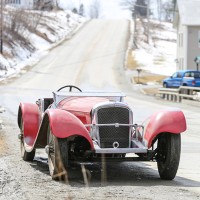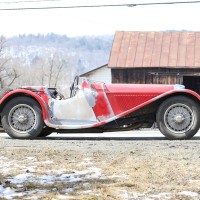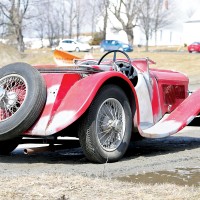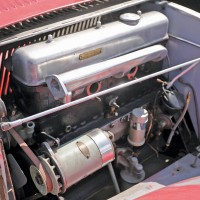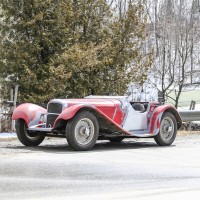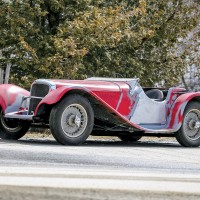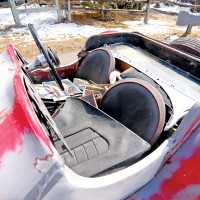SCM Analysis
Detailing
| Vehicle: | 1938 Jaguar SS 100 2½-Liter Roadster |
| Years Produced: | 1936–38 |
| Number Produced: | 198 (314 SS 100s) |
| Original List Price: | £395 ($1,833.75) |
| SCM Valuation: | $185,000–$230,000 |
| Tune Up Cost: | $250 |
| Distributor Caps: | $49 |
| Chassis Number Location: | Right side chassis rail, behind leaf spring mount and in line with starter motor |
| Engine Number Location: | Top rear right side of block on raised boss |
| Club Info: | Jaguar Drivers’ Club Ltd., Jaguar Clubs of North America |
| Website: | http://www.jaguardriver.co.uk/ |
| Alternatives: | 1934 Triumph Dolomite, 1936–40 BMW 328 roadster, 1948–49 Jaguar XK 120 aluminum roadster |
| Investment Grade: | B |
This car, Lot 293, sold for $215,000, including buyer’s premium, at Bonhams’ Greenwich Concours auction in Connecticut on May 31, 2015.
This was a very tempting project. If you asked anyone to sketch the definition of the traditional English sports car, they’d come up with something like the SS 100 (the marque was rebranded SS Jaguar in 1935 and then just Jaguar from 1945, as “SS” had become rather unpopular in much of Europe during that period).
Thanks to founder William Lyons’ vision, Jaguars were always great-looking cars, even if the oily, whirry bits within could be a bit prosaic — but that at least kept the cost down. Jags were always great value.
A footnote to Bonhams’ description said: “When collected from Mr. Howard’s garage, all evident boxes and parts annotated as being for this car were removed and every effort has been made by Bonhams to ensure that they accompany it. However, ultimately beyond the fact that the SS 100 was acquired as a complete car and then dismantled for restoration and remained in his ownership continuously, it is up to prospective purchasers to assess the completeness of the car as offered.”
These were slightly muddy waters because three SS Jaguars from the estate of the late Geoffrey Howard were being sold at this auction as consecutive lots. Along with a partly dismantled XK 150 restoration project, one was a complete and intact SS 90, which sold for almost the same figure as this project.
The third car was an SS 100 “tribute” that Mr. Howard had started around 1975, so it may be that as he dismantled the original he decided to use the dimensions to help him make a replica — but as this was Pinto-powered on a newly drafted chassis wearing a fiberglass body tub, and was completely undressed of any chrome, trim, instruments or windscreen parts, it’s unlikely any parts would have cross-pollinated between the three cars.
Rupert Banner of Bonhams consigned the car and helped haul it out of storage, and he reckons everything is there. But, as the description says, you just can’t tell. Luckily, if anything’s missing, there are a lot of repro widgets out there to help finish the project from the likes of Suffolk Sports Cars — at quite reasonable prices.
The original engine is long gone
Like so many SS 100s, this car has lost its original engine. This was because back in the day when they were just old cars of no huge value, no thought was given to preserving their originality. In the face of engine wear or trouble, a complete replacement unit was often the most cost-effective solution.
So, given that the 2½- and 3½-liter engines share external dimensions, why not up-gun to 3½ liters while you’re at it? Especially as a 1938 car like this could have been either, although the chassis number will always peg it as a mid-1938 2½. These were Standard-based motors, by the way, originally side valve but in the SSs fitted with overhead-valve heads devised by Harry Weslake and Willam Heynes, who was later responsible for the driveshaft-as-upper-link IRS first seen on the Mk 10 and which later went under the E-type, S-type and XJ6.
These replacement motors were often sourced from Mk IV and Mk V sedans, which means they lack the SS logo cast on the side of the block. I didn’t see this car personally, so have no way of telling if this was a genuine SS engine, but since it was post-war it seems highly unlikely. Either way, it’s not the original.
Only the very best cars with their original engines make top money, but a decent example is in the $340k–$400k range (which feels quite cheap given the tiny numbers — only 198 of the 2½-liter and 116 of the 3½-liter were made).
$150k of leeway before submerging
That means there’s around $150k of leeway to complete this project within its probable market value, beyond which the owner will find himself underwater. These cars, like the later Mk 2s, have only appreciated gently in the past five years, so don’t count on stratospheric Ferrari-, Aston- or Porsche-style rises in value to keep the project afloat.
SS Jaguars are fairly simple cars, and the difficult stuff, such as repairing the body frame and refitting panel work, is done. It’s the kind of project that an enthusiast (like Mr. Howard) could complete at home and, provided not too much of the work is farmed out, I reckon it could be completed on budget, although Roger Williams of Suffolk Sports Cars warned that for around $150k, the difference between the price paid here and its likely finished value, “it will be hard to do a good job.”
It’s marginal, but in my book that makes it a fair deal both ways. ♦
(Introductory description courtesy of Bonhams.)
